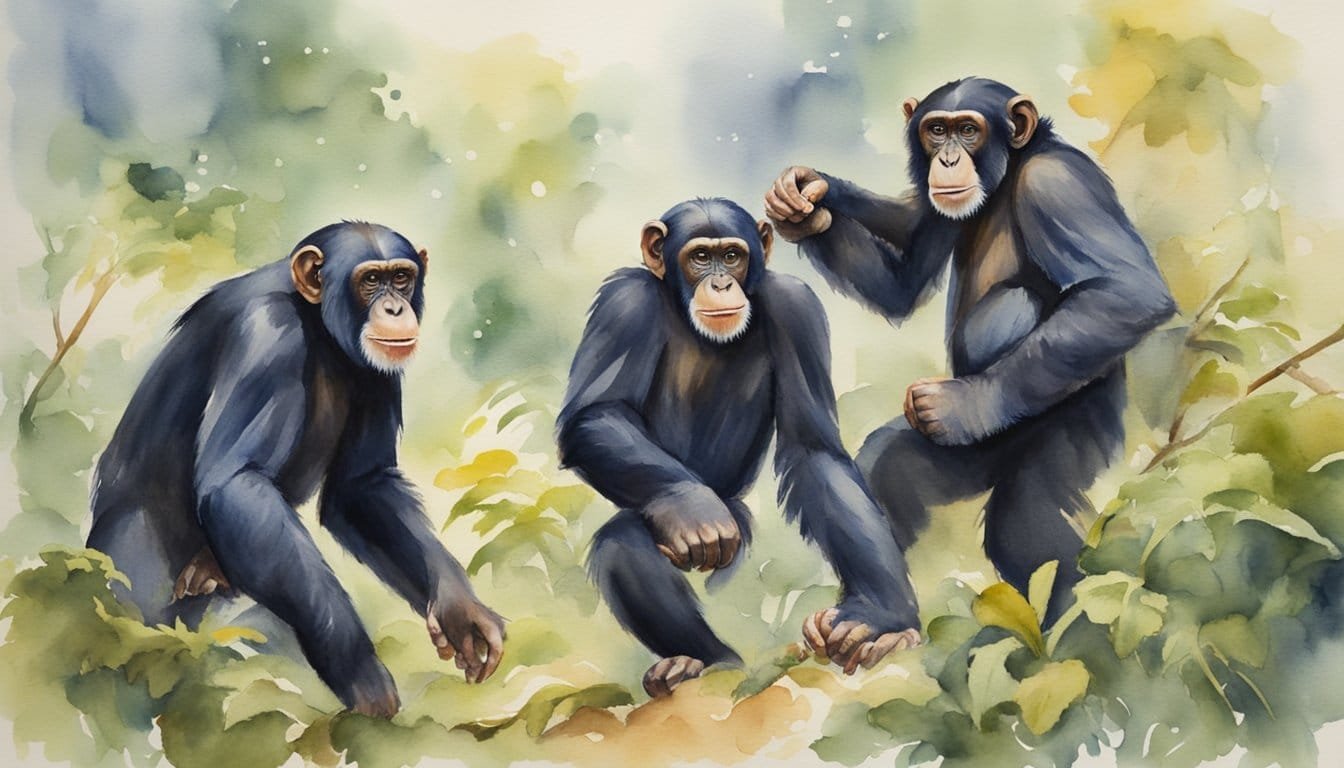Understanding Chimp Violence
Chimpanzee aggression can be quite startling, yet it is deeply rooted in their evolutionary biology and social structures. These behaviors have been shaped over millions of years and are influenced by factors such as social hierarchies, mating, and territory.
Evolutionary Background
Chimpanzees share a common ancestor with humans, and both species have been sculpted by the forces of natural selection. Aggression in male chimpanzees, particularly, may stem from the need to survive and reproduce in the wild. These violent behaviors that we observe today have likely been advantageous for ancestral males in both chimpanzees and human evolution, helping to secure resources and improve mating success.
Social Dynamics and Aggression
The social structure of chimpanzee communities revolves around a dominance hierarchy where the alpha male reigns supreme. This results in frequent skirmishes among males vying for higher status. Social relationships within these communities are an intricate dance of cooperation and competition, which can often spill over into violent encounters.
Mating Competition
Male chimpanzees are known to engage in aggression as a strategy for mating competition. They compete for access to female chimpanzees and use violence to fend off competition. Mating competition is intense, as success directly affects an individual male’s reproductive output and, consequently, his evolutionary fitness.
Territorial Warfare
Territorial disputes are another key driver of chimpanzee violence. Groups will actively patrol and defend their territory against neighboring communities. Encounters between opposing groups can lead to organized attacks and lethal aggression, often resulting in serious injury or death. This territorial warfare ensures control over areas rich in food and potential mates, making it a critical aspect of chimp survival strategies.
Effects of External Factors

Chimps can be fascinatingly complex creatures, and like any good drama, their behavior can be heavily influenced by outside influences. This section uncovers the pivotal role that external factors play in ramping up chimpanzee aggression.
Human Interaction and Impact
Chimpanzees have long been the subject of human research, providing insights into human evolution. However, interactions with humans can exacerbate chimp violence. Human impact extends from ecological changes to direct interference such as habitat loss and hunting, resulting in increased competition for resources. Studies suggest that human disturbance impacts chimp aggression, altering their natural behaviors and sometimes forcing them into more violent confrontations over dwindling territories and food supplies.
Habitat and Resource Challenges
Chimpanzees face intense pressure from environmental factors. Deforestation and habitat destruction are big challenges, leading to heightened aggression over territory and resources. With their habitat shrinking, chimpanzees battle over control of the remaining areas that provide them with food. This struggle for resources isn’t just localized—it reflects wider issues affecting endangered species globally. Moreover, changing conditions within their habitats due to climate factors or human-induced changes in ecology can further strain the stability of chimp communities.
Comparative Analysis: Chimps and Other Primates

When it comes to understanding primate behavior, comparing chimpanzees with their closest relatives provides fascinating insight into the evolution and variations of aggression in these animals.
Chimps vs Bonobos
Chimpanzees and bonobos, two close relatives in the primate world, exhibit remarkably different social behaviors. Chimpanzees are known for their aggressive intergroup relations, often leading to violent encounters. In contrast, bonobos are recognized for their more peaceful and cooperative societies. Bonobos engage in social bonding behaviors that help mitigate conflict, and these behaviors are thought to play a key role in the sharp contrast between them and their chimpanzee cousins. This divergence is likely linked to ecological differences in their environments and evolutionary pressures that have shaped each species’ social strategies.
Primate Aggression Studies
Research into primate aggression offers a window into the nature of violence and cooperation among non-human animals. Studies conducted by institutions, like the University of Minnesota, have highlighted the varying degrees of aggression exhibited by different primate species. Primatology, combining aspects of anthropology, biology, and psychology, has pointed to the multifaceted causes of aggression, from resource competition to societal structures. For instance, gorillas exhibit less frequent aggression but with considerable severity when it occurs, while common chimpanzee violence is more frequent but can vary in intensity. Researchers like Richard Wrangham have written in publications like Scientific American and the Journal Nature about the evolutionary roots and implications of such aggressive behaviors, providing a deeper understanding of how aggression in primates mirrors aspects of human society.

